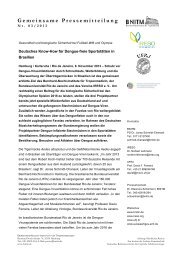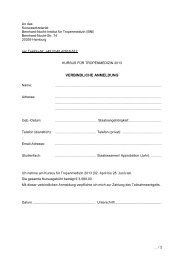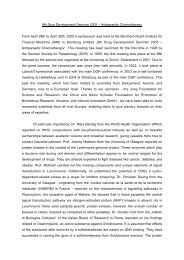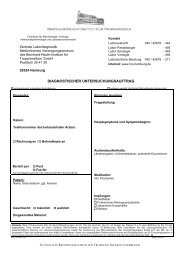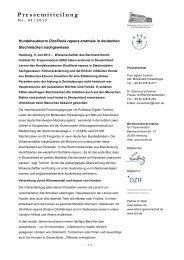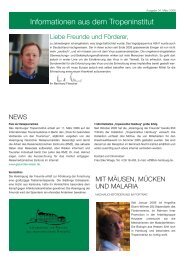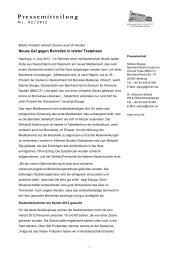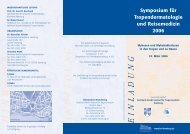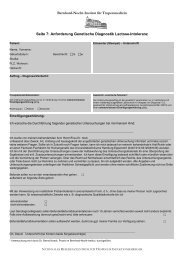Research Group Heussler (Malaria I) - Bernhard-Nocht-Institut für ...
Research Group Heussler (Malaria I) - Bernhard-Nocht-Institut für ...
Research Group Heussler (Malaria I) - Bernhard-Nocht-Institut für ...
You also want an ePaper? Increase the reach of your titles
YUMPU automatically turns print PDFs into web optimized ePapers that Google loves.
Parasitology Section<br />
Survival strategies of<br />
Plasmodium parasites in hepatocytes<br />
Zusammenfassung<br />
Wir benutzen den Nagerparasiten Plasmodium berghei<br />
als einen Modellorganismus, um die Überlebensstrategien<br />
von Plasmodien in Hepatozyten zu untersuchen.<br />
Im Hepatozyten leben die Plasmodien<br />
zunächst in einer parasitophoren Vakuole. Während<br />
der Merozoitenbildung wird die Vakuolenmembran<br />
zerstört und die Parasiten gelangen ins Wirtszellzytoplasma.<br />
In vitro konnten wir beobachten, dass sich<br />
die infizierten Zellen nach der Auflösung der Vakuolenmembran<br />
abrundeten und frei im Medium<br />
schwammen. Diese frei schwimmenden Zellen zeigten<br />
intrazellulär Eigenschaften von apoptotischen<br />
Zellen. Die Zellmembran blieb dagegen zunächst intakt,<br />
was den Schluss nahe legt, dass infizierte Zellen<br />
nicht von phagozytierenden Zellen erkannt und<br />
eliminiert werden können. Untersuchungen der molekularen<br />
Mechanismen dieser Parasit-Wirtszell Interaktionen<br />
sollen helfen, die Biologie des Leberstadiums<br />
von Plasmodien besser zu verstehen und Strategien<br />
zu entwickeln, die die Entwicklung der Parasiten<br />
in der Leber hemmen.<br />
Summary<br />
Using the rodent parasite Plasmodium berghei as a<br />
model system we investigate survival strategies of Plasmodium<br />
parasites in hepatocytes. Within the host cell<br />
Plasmodium parasites live initially in a parasitophorous<br />
vacuole. During merozoite formation the vacuole membrane<br />
is destructed and the parasites lie free in the host<br />
cell cytoplasm. In vitro we observed that upon the degeneration<br />
of the PVM, parasitised host cells rounded<br />
off and floated in the culture medium. These floating<br />
cells exhibited intracellular features of apoptotic cells.<br />
However, at first the cell membrane of the host cell remained<br />
intact suggesting that infected cells cannot be<br />
recognized and eliminated by phagocytising cells. Investigating<br />
the molecular mechanisms of these parasite-host<br />
cell interactions will help to understand the biology<br />
of the liver stage of Plasmodium and to improve<br />
strategies to inhibit the development of the parasite in<br />
the liver.<br />
Project Description and Results<br />
<strong>Malaria</strong> is caused by parasites of the genus Plasmodium<br />
and is transmitted by Anopheles mosquitoes. During<br />
a blood meal infected mosquitoes inject Plasmodium<br />
sporozoites into the skin of the mammalian host.<br />
From there the sporozoites reach the circulatory system<br />
and are transported to the liver, where they infect hepatocytes.<br />
The invasion of hepatocytes by Plasmodium<br />
42<br />
sporozoites is a well-documented event, but little is<br />
known how the parasite survives in the host cell and<br />
how exoerythrocytic merozoites are finally liberated.<br />
Although the host cell has principally the capacity to<br />
counteract the infection by committing suicide, Plasmodium<br />
parasites can obviously grow and develop intracellularly<br />
suggesting that the parasite interferes with<br />
pathways leading to programmed cell death (apoptosis).<br />
In order to investigate whether parasite infection protects<br />
the host cell from apoptosis, we treated two days<br />
infected cultures with concentrations of peroxide which<br />
induces programmed cell death in non-infected cells.<br />
Immunofluorescence studies revealed that infected<br />
cells are indeed protected against peroxide treatment<br />
confirming our assumption that the presence of the parasite<br />
confers resistance to apoptosis to its host cell.<br />
As long as the parasite develops and grows in the hepatocyte<br />
it is an advantage for the pathogen to support<br />
the survival of the host cell. But what happens when<br />
merozoites are formed which must leave the cell to infect<br />
red blood cells? We examined the final stage of<br />
parasite development in transformed hepatic cell lines<br />
and in primary hepatocytes in vitro and observed very<br />
interesting changes in infected cells. Three days post<br />
infection most P. berghei-infected cells lost adherence<br />
to the surface and to other cells in the culture. They<br />
rounded off and floated into the culture supernatant.<br />
Floating infected cells exhibited features of early apoptotic<br />
cells including nuclear condensation of the host<br />
cell nucleus, cytochrome c release from the mitochondria<br />
and caspase activation. However, another early<br />
marker of apoptosis, the loss of cell membrane asymmetry,<br />
could not be detected for several hours in infected<br />
floating cells and was only apparent briefly before<br />
merozoites are released.<br />
What could be the biological relevance of these observations?<br />
Our working hypothesis is that in vivo parasitised<br />
cells loose contact to their neighbouring cells<br />
and are bulged out between the normal hepatocytes.<br />
The later phases of intracellular parasite development<br />
are taking place in the space of disse or in the sinusoids<br />
of the liver (figure 1). Since the membrane of infected<br />
floating cells was found intact it is reasonable to<br />
assume that parasitised cells cannot be recognized by<br />
phagocytosing cells of the immune system. We believe<br />
that the observed membrane integrity in an otherwise<br />
apoptotic cell is actively preserved by the parasite and<br />
can thus be considered as a so far unknown immune<br />
evasion mechanism.



